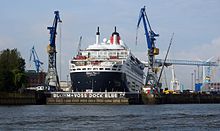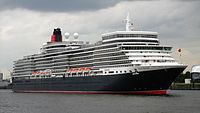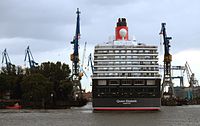Elbe dry dock 17
The Elbe 17 dry dock is one of the largest dry docks in Europe. It is located on the premises of the Blohm + Voss shipyard in the port of Hamburg opposite the landing stages . It is mainly used for repairing ships, but can also be used for new builds.
Technical specifications
| length | 351.2 m |
| width | 59.2 m |
| Draft | 9.7 m |
| volume | 240,000 m³ |
| Pump performance | 3 × 11,000 m³, total 33,000 m³ |
| Maximum ship size | 320,000 dwt |
| Cranes | 2 × 10 t 2 × 50 t |
history
In May 1938 the High Command of the Navy (OKM) issued the construction contract for a dry dock 351 m long, 59 m wide and a water volume of 240,000 m³, which could be emptied by three pumps with an output of 11,000 m³ per hour. It was planned as a construction and repair dock for the 62,496 t H-class battleships ( Z plan ), which would have had a length of 277.8 m and a width of 37.2 m. In order to avoid settlement due to the enormous weight of the ships, the floor slab of the dry dock was made of 9 m thick reinforced concrete. The Z-Plan was discarded at the beginning of the war , but the dock was completed in 1942 despite the high costs, but no longer used as a construction dock. During the war, its concrete walls and the cavities embedded in them also served as air raid shelters for the workforce. They offered space for 6,000 people seeking protection.
It was erected partly on the Blohm & Voss shipyard and partly on the site of the former Janssen & Schmilinsky shipyard . It was built by Dyckerhoff & Widmann KG from Munich. It was paid for by the Reich Ministry of Finance . Blohm & Voss , as trustee, had to carry out the construction work and make the dock operational, and in the event of use also to manage and operate it. The owner was still the German Reich.
After the end of the war, the gate was dismantled and the dock was used as a harbor basin. Opposition to the order of the British occupation forces to blow up the dock in January 1950, the public opinion ran storm, especially since the old Elbe tunnel , which is barely 150 meters away, could have been affected by the detonations . On the day of the planned demolition, thousands of people gathered on the St. Pauli Landungsbrücken , along the Hafenstrasse , on the Stintfang and on Steinwerder to emphatically protest against the measure. The demolition was postponed at the last minute, and soon afterwards the order was lifted.
Industrialist Willy Schlieker had the dock repaired and reopened on June 2, 1959, at a cost of DM 6 million .
Only after the completion of a new dock gate was the 190,000 t tanker Myrina the first to return to dry dock on December 12, 1967 .
The five largest ships that ever docked were the three structurally identical cruise ships Quantum of the Seas (348 m long, 41.4 m wide; 23-25 October 2014), Anthem of the Seas (23-26 March 2015 ) and Ovation of the Seas (March and April 2016), Norwegian Escape and Independence of the Seas .
- Docking of the Queen Elizabeth in dry dock Elbe 17 at Blohm & Voss - May 16, 2014
The Cunard Liner Queen Elizabeth enters the port of Hamburg
The port pilots navigate the ship extremely carefully into the correct docking position with the aid of the Azipod propulsion system and bow thruster
At a very slow speed against the running water , the ship comes closer to the Elbe 17 dry dock
Web links
Individual evidence
- ↑ a b c d e docks & systems at www.blohmvoss.com
- ↑ a b Ronald Rossig: Hamburg bunker. Dark Worlds of the Hanseatic City, Ch. Links Verlag 2014, p. 42 f.
- ↑ Quantum of the Seas comes to Hamburg. October 13, 2014, accessed October 14, 2014 .
Coordinates: 53 ° 32 ′ 30 " N , 9 ° 57 ′ 47" E












